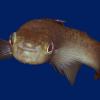Water tiger infestation
#1

Posted 23 April 2019 - 11:35 AM
#2

Posted 24 April 2019 - 12:35 AM
If your ponds are outdoors and open air, which seems likely from the use of the term "ponds", you probably didn't introduce anything into your ponds that isn't there already, since water tigers are the larvae of predaceous water beetles, and those fly well. You probably have dragon fly larvae in there too!
I don't know what would eat the water tigers, but probably some largish predatory fish. Which in your aquarium probably would eat the Heterandria too.
Water tigers likely are some degree of threat to small fish, and my guess is that Heter would be especially at-risk, given that they are constantly inspecting and poking at [tiny things on] aquarium plants, and thus would put themselves in grabbing range of lurking water tigers. But the good news is that the larger the water tigers are, the more of a threat they are, and vice versa. This is good news because the larger they are, the more likely it is that you'll notice them in your tank. And remove them one by one, as the apex predator that you are. (I don't know if the larvae can bite or pinch, but they look like they could. The adults definitely can.)
You could pull all of the plants back out of the aquarium, and rinse them in a potassium permanganate (fairly toxic, find and follow directions, store safely) or bleach solution. I bought some of the potassium permanganate once, but I've never actually used it, I usually just give wild-caught plants a quick shake in a bucket and that's it. Sometimes I don't even think to do that. I've never introduced anything disastrous into a tank, that I know of. Biodiversity is natural, isn't it?
The www says that adult predaceous water beetles can live 2 to 3 years, but in my quick search I didn't see anything that says how long they can stay in the larval form. Annual or until they get large enough to move their next life stage, probably. They're not going to die because they can't get to land, all the life stages are aquatic, with the flying mobility option for adults.
Think positively ... this just gives you more excuse to spend quality time watching your fish tank. It's not a disaster, it's an adventure and opportunity to learn more about nature in its magnificence.
HTH.
Doug Dame
Floridian now back in Florida
#3

Posted 24 April 2019 - 05:42 AM
#4

Posted 24 April 2019 - 07:46 AM
Older aquarium literature recommends rinsing collected plants in a salt solution to free them of critters. Realize that the salt is also toxic to most freshwater plants, so a short dip and swish would be suggested. If I were doing it, I'd make a brackish solution of half marine saltwater with a specific gravity of 1.012 - 1.014. You can get an inexpensive hydrometer in most fish stores to measure the specific gravity. I'd probably put the plants in that water for 30 seconds to a minute to cause the insects and other invertebrates to release from the plants.
I recognize brackish water when collecting in coastal streams by the almost total lack of aquatic plants other than algae, and the lack of insects except for water striders. I've had very good luck keeping brackish topminnows and other killifish for years at the above specific gravity,
The life cycle times of predaceous diving beetles refer primarily to the larval (water tiger) lifespans. The smaller species, whose adult beetles are one inch long or shorter typically have one to two year life cycles. The larger species whose adults and larvae get to about 2 inches long live 2-3 years in the larval (water tiger) stages. I've kept large predaceous diving beetle adults over a year in aquaria where they learned to eat fish food, but that would not be likely in nature. They probably would have died shortly after reproducing in nature. They have small mouths as adults and are not a threat to all but the smallest fish. You do need a tight cover on the tank to keep them from flying out.
The larger water tigers over one inch long can give a painful nip. Typically, they try to bite the fingertips where the skin is thicker, and they can't penetrate the skin. However, you'll know it if they bite lower on a finger or the palm of your hand.
Phil Nixon
Entomologist
#5

Posted 24 April 2019 - 07:59 AM
1 user(s) are reading this topic
0 members, 1 guests, 0 anonymous users








